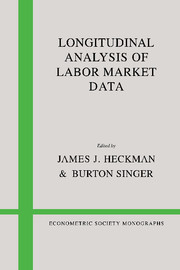Book contents
- Frontmatter
- Part I. Econometric studies
- Part II. Statistical studies
- 5 Weighting, misclassification, and other issues in the analysis of survey samples of life histories
- 6 Statistical models for longitudinal labor market data based on counting processes
- 7 Assessing qualitative features of longitudinal data
- Part III. Sociometric studies
- Name Index
- Subject Index
6 - Statistical models for longitudinal labor market data based on counting processes
Published online by Cambridge University Press: 05 January 2013
- Frontmatter
- Part I. Econometric studies
- Part II. Statistical studies
- 5 Weighting, misclassification, and other issues in the analysis of survey samples of life histories
- 6 Statistical models for longitudinal labor market data based on counting processes
- 7 Assessing qualitative features of longitudinal data
- Part III. Sociometric studies
- Name Index
- Subject Index
Summary
The aim of this chapter is to present a survey of how the statistical theory of multivariate counting processes can be useful when studying labor market dynamics. Throughout it will be assumed that longitudinal data are available on some sample S of individuals during a fixed calendar time interval I = [to,t1].
We shall be working with the basic three-state model illustrated in Figure 1. The state “unemployed” will be denoted 0, the state “employed” will be denoted 1, and the state “out of labor force” will be denoted 2. The number of individuals in state i (i = 0,1,2) at time t — (t ϵ I) is denoted Yi (t) . The requirement of having longitudinal data implies that for each individual v ϵ S and for each time t ϵ I the state to which v belongs at t is known and thus that Y0 (t), Y1 (t) and Y2 (t) are known and that the numbers Nij(t) of direct transitions from i to j before t are known. These stochastic processes Ntj (t) counting the transitions between the states are the basic observations, and in the rest of this chapter statistical models for these counting processes will be discussed. In the presentation, only references to the statistical literature where these methods have been developed will be given. The methods will, however, be related to the specific problem of studying unemployment, and as far as possible terminology from econometrics will be used. Also, in the final section of the chapter the models will be related to various models suggested previously in the econometric literature.
- Type
- Chapter
- Information
- Longitudinal Analysis of Labor Market Data , pp. 294 - 307Publisher: Cambridge University PressPrint publication year: 1985
- 1
- Cited by

